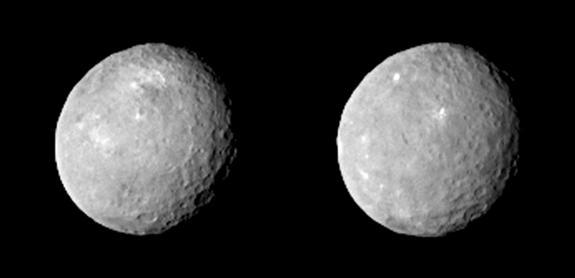Two interesting news reports.

An image of Ceres taken by NASA's Dawn spacecraft shows that
the brightest spot on the dwarf planet has a dimmer companion.
NASA/JPL-Caltech/UCLA/MPS/DLR/IDA
Mike Balls, AV Chronicle 26 February, 2015
In light of the reported dark green skies over Canada and Russia recently and the growing conspiracy theories not to mention the increasing number of UFO sightings and mystery drones spotted over France since last October this latest news has fuelled more speculation.
Professor Peter Sidebotham from the European Space Agency Deep Space Project told a recent news conference in Lucerne: "There can be little doubt that there have been recent nuclear explosions on the surface of Mars" and at a hurried meeting of the Deep Space Project, Sidebotham told a reporter for CNN: "I think we have visitors to our solar system and they are not friendly" (CNN News 23 January, 2015.
There is now a statement from Professor John Chance of the Lucerne Deep Observation Agency that similar explosions have been seen on other planetary bodies in the solar system including Ceres and that these explosions are clearly seen on NASA photographs.
Both NASA and the European Space Agency have denied observing large artificial objects moving near to Mars. Asked about the claims of the two scientists both agencies released replies worded exactly the same: "We cannot comment at this moment."
__________________________________ and ____________________________________
By Mike Wall | SPACE.com
NASA's
Dawn spacecraft will have plenty of mysteries to investigate when it
begins orbiting the dwarf planet Ceres next month, as the probe's latest
photos attest.
"As we slowly approach the stage,
our eyes transfixed on Ceres and her planetary dance, we find she has
beguiled us but left us none the wiser," Dawn principal investigator
Chris Russell of UCLA said in a statement. "We expected to be surprised; we did not expect to be this puzzled."
A large, flickering white spot was also visible in photos Dawn took of Ceres last month.
"We can confirm that it is something on Ceres that reflects more sunlight, but what that is remains a mystery," Dawn mission director and chief engineer Marc Rayman, of NASA's Jet Propulsion Laboratory in Pasadena, California, told Space.com via email at the time
Dawn could clear up the mystery soon. The probe is scheduled to enter orbit around the 590-mile-wide (950 km) Ceres, the largest body in the main asteroid belt between Mars and Jupiter, on the night of March 5. Dawn will start studying Ceres in earnest six weeks after that; the probe is scheduled to work its way down to its first science orbit on April 23.
The $466 million Dawn mission launched in September 2007 to study the asteroid belt's two biggest denizens — the protoplanet Vesta, which is 330 miles (530 km) wide, and Ceres. Dawn orbited Vesta from July 2011 through September 2012, when it departed for Ceres.
Dawn's observations of these two planetary building blocks should help scientists better understand the solar system's early days, NASA officials said.
Dawn is scheduled to study Ceres from a variety of orbits through June 2016, when the probe's mission will come to an end.
This is a The Green Skies promotion NOT reality


No comments:
Post a Comment